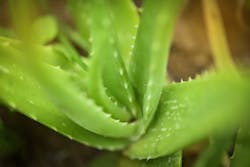In today’s world, dental product options for consumers are seemingly endless. As our patients visit their local pharmacies, grocery stores, and health stores, they find oral hygiene aisles filled with a variety of toothbrushes, toothpastes, and mouth rinses. Among the options, there has been a consistent increase in products advertised as “natural.” More recently, many of these "natural" products contain an ingredient in common—aloe. Let’s take a closer look into aloe-based products, and determine if aloe is a worthy ingredient for our hygiene patients to look for.
Aloe is defined as “a succulent plant, typically having a rosette of toothed fleshy leaves and bell-shaped or tubular flowers on long stems. Several species are cultivated commercially or as ornamentals.”1 The first use of aloe-based products in the United States was in the 1800s, when it was used commercially as a laxative. By the mid-1900s, its healing effects were discovered and often used to heal dermatitis.2 So, what makes this plant so great?
Aloe is most notably known for its healing benefits. Aloe contains more than 70 active ingredients, including minerals, enzymes, and amino acids. It contains vitamins known to benefit hard and soft oral tissues, such as Vitamin A, Vitamin C, and Vitamin E, with each of these being antioxidants. Enzymes found in aloe, including cellulase, alkaline phosphatase, and peroxidase, aid in decreasing inflammation. Its minerals, such as calcium, magnesium, and zinc, are known to benefit the oral cavity. Combined, what we find in aloe provides for healing and moisturizing effects of the oral mucosa, anti-inflammatory properties, and antiseptic effects.
Rinses containing aloe have been shown to effectively decrease inflammation of gum tissue and healing of soft-tissue lesions. Aloe-based mouth rinses have been shown to be equally as effective in reducing periodontal problems as chlorhexidine. A triple-blind study was conducted that evaluated aloe mouth rinse, chlorhexidine, and distilled water and their effects against reducing plaque and gingivitis. The study consisted of 345 healthy subjects who were randomly divided into three groups. Each group was asked to use its mouth rinse twice a day over a 30-day period. The results showed that the aloe mouth rinse was as equally effective as chlorhexidine. The study concluded that aloe mouth rinses may be an elite option, in that aloe showed none of the negative side effects associated with chlorhexidine.3
So, we’ve established the science of aloe, and it’s been deemed a worthy option for our patients. Why not find products that can be a more “natural” option with fewer harmful side effects?
There are a few aloe-based products on the market promoted to dental professionals. I’ve found personal success with products containing aloe. I’ve found patients to be consistently more compliant with an aloe-restoring rinse. The technology behind an aloe-based rinse allows for supragingival microfoaming removal of debris, microbes, and irritants, which includes a significant reduction of aerobic and anaerobic bacteria.
The aloe products I've used contain several of the minerals, enzymes, vitamins, and amino acids previously discussed, and promote healing without harmful side effects. In my practice, when I make an effort to provide my patients with alternatives in their home care, it gives patients opportunities to find a set of products that work best for each individual and his or her ever-changing needs.
References
1. Aloe. Merriam-Webster website. https://www.merriam-webster.com/dictionary/aloe.
2. Surjushe A, Vasani R, Saple DG. Aloe vera: A short review. https://www.ncbi.nlm.nih.gov/pmc/articles/PMC2763764/. Published 2008.
3. Karim B, Bhaskar DJ, Agali C, Gupta D, Gupta RK, Jain A, Kanwar A. Effect of aloe vera mouthwash on periodontal health: Triple blind randomized control trial. https://www.ncbi.nlm.nih.gov/pubmed/24603910/. Published March 2014.
Mandy Macachor, RDH, is a practicing clinician in Milwaukee, Wisconsin, with experience in cosmetic and general practices. Mandy is licensed to administer local anesthetic and nitrous oxide, as well as utilize laser technology. In addition to being the lead hygienist within her practice, she is the practice's social media brand manager. She was the president of her Student American Dental Hygienists’ Association and is a current member of the American Dental Hygienists' Association. She is currently pursuing her bachelor's degree in health communications through Arizona State University.
About the Author

Mandy Macachor, RDH
Mandy Macachor, RDH, is a practicing clinician in Milwaukee, Wisconsin, with experience in cosmetic and general practices. Mandy is licensed to administer local anesthetic, nitrous oxide, and utilize laser technology. In addition to being the lead hygienist within her practice she is also their social media brand manager. She was the president of her alma mater Student American Dental Hygienists’ Association and is a current member of ADHA. She is currently pursuing her bachelor's degree in health communications at Arizona State University.
Updated December 1, 2018
